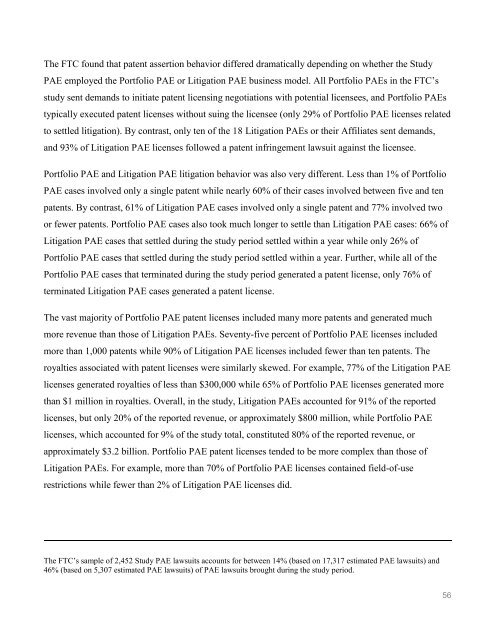You also want an ePaper? Increase the reach of your titles
YUMPU automatically turns print PDFs into web optimized ePapers that Google loves.
The FTC found that patent assertion behavior differed dramatically depending on whether the Study<br />
PAE employed the Portfolio PAE or Litigation PAE business model. All Portfolio PAEs in the FTC’s<br />
study sent demands to initiate patent licensing negotiations with potential licensees, and Portfolio PAEs<br />
typically executed patent licenses without suing the licensee (only 29% of Portfolio PAE licenses related<br />
to settled litigation). By contrast, only ten of the 18 Litigation PAEs or their Affiliates sent demands,<br />
and 93% of Litigation PAE licenses followed a patent infringement lawsuit against the licensee.<br />
Portfolio PAE and Litigation PAE litigation behavior was also very different. Less than 1% of Portfolio<br />
PAE cases involved only a single patent while nearly 60% of their cases involved between five and ten<br />
patents. By contrast, 61% of Litigation PAE cases involved only a single patent and 77% involved two<br />
or fewer patents. Portfolio PAE cases also took much longer to settle than Litigation PAE cases: 66% of<br />
Litigation PAE cases that settled during the study period settled within a year while only 26% of<br />
Portfolio PAE cases that settled during the study period settled within a year. Further, while all of the<br />
Portfolio PAE cases that terminated during the study period generated a patent license, only 76% of<br />
terminated Litigation PAE cases generated a patent license.<br />
The vast majority of Portfolio PAE patent licenses included many more patents and generated much<br />
more revenue than those of Litigation PAEs. Seventy-five percent of Portfolio PAE licenses included<br />
more than 1,000 patents while 90% of Litigation PAE licenses included fewer than ten patents. The<br />
royalties associated with patent licenses were similarly skewed. For example, 77% of the Litigation PAE<br />
licenses generated royalties of less than $300,000 while 65% of Portfolio PAE licenses generated more<br />
than $1 million in royalties. Overall, in the study, Litigation PAEs accounted for 91% of the reported<br />
licenses, but only 20% of the reported revenue, or approximately $800 million, while Portfolio PAE<br />
licenses, which accounted for 9% of the study total, constituted 80% of the reported revenue, or<br />
approximately $3.2 billion. Portfolio PAE patent licenses tended to be more complex than those of<br />
Litigation PAEs. For example, more than 70% of Portfolio PAE licenses contained field-of-use<br />
restrictions while fewer than 2% of Litigation PAE licenses did.<br />
The FTC’s sample of 2,452 Study PAE lawsuits accounts for between 14% (based on 17,317 estimated PAE lawsuits) and<br />
46% (based on 5,307 estimated PAE lawsuits) of PAE lawsuits brought during the study period.<br />
56


